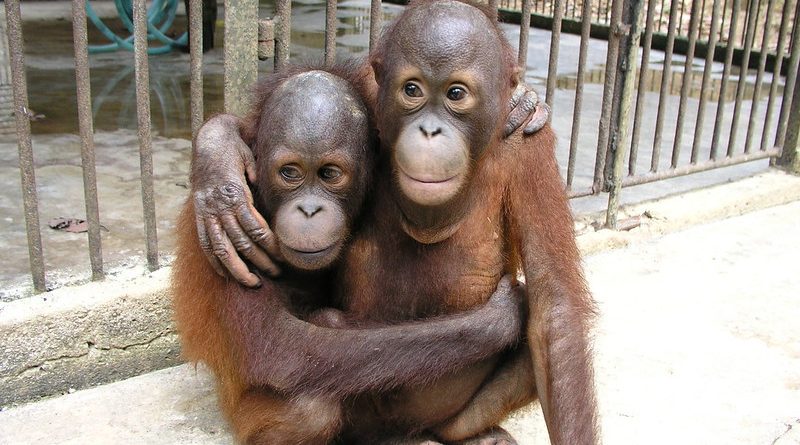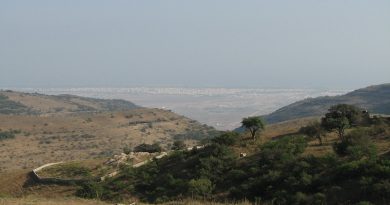Planet Of The Apes
The primate family, most closely related to humans, is in danger of becoming extinct. This is largely due to the activities of the nearly seven billion humans inhabiting the earth. These harmful activities include the cutting down of the rainforest, the bush meat trade as well as the pet trade. While a large majority of primates exist within three continents: South America, Africa and Asia, others only remain in smaller areas or one specific country.
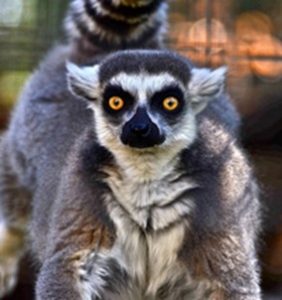
The Lemur
The lemur exists only on the island of Madagascar and many are protected in Ranomafana National Park. The lemur evolved separately from other primates over 50 million years ago, when Madagascar separated from the African continent. Over sixty different species are recognized today. One of the most rare species that exists today is the Golden Bamboo Lemur, a shy animal, which feasts on a diet solely of bamboo and is under increasing threat.
Lemurs have evolved to cope with an extremely seasonal environment and their adaptations give them a level of diversity that rivals that of all other primate groups. Until shortly after humans arrived on the island around 2,000 years ago, there were lemurs as large as a male gorilla.
Roosmalens’ dwarf marmoset, also known as the black-crowned dwarf marmoset, was discovered in the Amazon in the 1990s. The dwarf marmoset is known to exist in Nova Olinda. It is a small (four inches from head to tail) New World monkey native to the Amazon Rainforest, on the east bank of the lower Madeira River, and the west bank of the Aripuanã River, in Brazil. They live in large groups up to thirty and it is the second smallest monkey. The dwarf marmoset has the smallest distribution of any primate in Amazonia. It is considered unusual among marmosets in that it gives birth to only a single baby instead of twins, the norm for marmosets. Marmosets are often very territorial, though this is not the case among Roosmalens’ dwarf marmoset, where it is common for multiple females in a group to have young, instead of one dominant female.
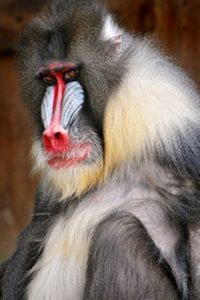
Drills And Mandrills
The Drill (Mandrillus leucophaeus) is a primate of the family Cercopithecidae (Old World monkeys), closely related to baboons and most closely related to mandrills. The drill is a short-tailed monkey up to 70 cm (28 in) long, similar in appearance to the mandrill, but lacks the bright blue and red on the face of the mandrill. It has high sexual dimorphism in weight, with males weighing up to 50 kg (110 lb) and females up to 12.5 kg (27.5 lb). The body is overall a dark grey-brown. Mature males have a pink lower lip and white chin on a dark grey to black face with raised grooves on the nose. The rump is pink, mauve and blue. Female drills lack the pink chin.
Furthermore, drills are the most endangered species of the African primates due to the fact that they are hunted to serve on the dinner table. According to British vet and former head of the Limbe Wildlife Center, Felix Lancaster, there are only 3,000 drills remaining. Hunters get approximately $1000 per drill when they sell them to different restaurants. Due to this harsh reality, the health of these animals is crucial. The Limbe Wildlife Center is a wildlife rescue and rehabilitation center. The project collaborates with state and national governments, communities and other international and local NGOs in order to protect habitat and endangered species.
Cameroon is the ideal location for the wildlife centre because it has one of the most diverse ranges of any plant and animal species of any country in the world. To be exact, the centre nurtures fourteen species of primates from gorillas and monkeys to reptiles and birds.
The mandrill (Mandrillus sphinx) is a primate of the Old World monkey family, closely related to the baboons and even more closely to the drill. It is found in southern Cameroon, Gabon, Equatorial Guinea, and Congo. Mandrills mostly live in tropical rainforests and forest-savanna mosaics. They live in groups called hordes. Mandrills have an omnivorous diet consisting mostly of fruits and insects.Their mating season takes place from June to October. Typically there are four to five hundred mandrills in their group, making them one of the largest groups of animals. The female population of mandrills outweighs the male population, but the male can be five times larger than the female. Often times, it’s rare to see mandrills in the wild. They travel three miles per day feasting on fruit trees, seeds and insects.
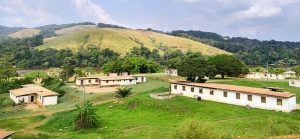
Lope National Park
Lope National Park, which is mainly rainforest, is located in Gabon and is the best place to see mandrills. This park was the first protected area in the country after the creation of the Lope-Okanda Wildlife Reserve in 1946. Mammal species include the forest elephant, western lowland gorillas, chimpanzees, mandrills, forest buffalo, sun-tailed guenon as well as several species of birds. The wide range of animals that are living here are under constant threat from hunting and ivory poaching as well as commercial logging, therefore a training center has been established to train young African conservationists and a good educational program functions throughout the bordering villages to inform them more about wildlife issues.
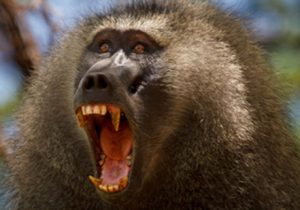
Baboons
Baboons are widespread, found mostly in Africa and Arabia and as long as there is a plentiful amount of water, baboons can be found living in a range of habitats. These include: savanna, scrub, rocky deserts and rainforests. Although, they are more adaptable at living alongside humans, conflict between humans and baboons is quite common and despite their large quantities, they still need to be protected.
There are five different species of baboons and they are some of the world’s largest monkeys. Depending upon their species, male baboons range in weight from 33-82 pounds. It’s known that the most powerful male baboons have a highly active sex life.
Like other old world monkeys, baboons do not have prehensile tails or tails that grip but they are still able to climb trees for the purposes of eating, sleeping or to look out to see what’s happening below. Even though baboons have tree-climbing skills, they spend the majority of their time on the ground. The baboon diet consists of a wide variety of plants and animals as well as parts of trees, such as bark. They also eat fruits, grasses, seeds and roots and have a strong fondness for meat. Additionally, birds, rodents, and even the young of larger mammals, such as antelopes and sheep are part of a baboon’s diet.
A baboon’s strength can be terrifying. Baboons can become dangerous if they are provoked or feel that their territory is threatened.
They can also be dangerous when they have been socialized to associate humans with food. Males will often show their large front teeth as a warning sign. If you don’t take note of this, they can charge at you. Baboons can also vocalize sounds of alarm when they feel threatened. If a baboon is threatened enough to charge and then bite you, its bite can easily break bones or even kill, as male baboons have long, sharp incisors and incredibly powerful jaws.
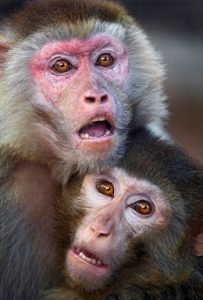
Macaque
The macaques are the most widespread primate genus, living in places from Japan to Afghanistan and, in the instance of the barbary macaque (Macaca sylvanus), to North Africa and Southern Europe, however they are native to North Africa and Asia. Twenty-two macaque species are currently recognized. Some of these include: the barbary macaque, the crab eating macaque, the bonnet macaque, the Japanese snow macaque, the Japanese macaque, the rhesus macaque, the Tibetan macaque, among many others.
The lion tailed macaque is considered the rarest and most threatened of the primates.
Their range has become increasingly isolated and fragmented by the spread of agriculture and tea, coffee, teak and cinchona, construction of water reservoirs for irrigation and power generation, and human settlements to support such activities.
They do not live, feed or travel through plantations. Destruction of their habitat and their avoidance of human proximity has led to the drastic decrease of their population. However, according to an article in “The Hindu” in June 2013, the lion tailed macaque was no longer on “‘The World’s 25 Most Endangered Primates’ list, after the international body compiling it determined that the State governments had acted positively to protect it.
The Macaque And Coconuts
These monkeys are employed and trained to pick coconuts. There is even a monkey school in Thailand to fully train the monkeys. The long–tailed or pig-tailed macaques are used to farm coconuts on plantations. Although the monkeys can live for over 25 years, they need to be specially trained at an early age if the main goal is to become coconut pickers who work at heights of twenty meters or more.
In Surat Thani, Southern Thailand, the Monkey Training College has been in operation since 1957 when the late Somporn Saekhow started his monkey training school. Somporn’s training methods were considered unconventional and strange in the late 1950s when he first started training macaques to climb trees, pick coconuts and toss them down to the ground. Instead of punishing the monkeys for bad performance like some of their owners had done, Somporn’s method was training them through love and positivity.
The training is divided into three parts: During the first term, the macaques were trained on how to choose ripe coconuts and spin them free from their stems as well as how to free themselves if their rope attachment becomes entangled in the trees. Secondary school training comes next. The monkeys are taught to collect all of the coconuts that have fallen on the ground and place them into sacks or load them onto a truck. This saves the handlers from paying out excessive labor costs. The third part of training is high school, where the monkeys finish and the trainers teach to the owners’ specific requirements. Compared to a fit, experienced human, who can pick approximately 100 fruits in an eight hour day, a well trained male coconut monkey can pick over 1,000 per day.
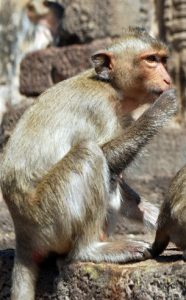
Lopburi
Monkeys rule the streets in Lopburi, a town in Thailand that has an extremely overwhelming monkey population. The monkeys in Lopburi will steal food at any opportunity and raid restaurants and private houses. Due to the fact that Buddhist and Hindu tribes hold the monkeys to be sacred, the monkeys are greatly protected. Consequently, the monkey population has actually boomed. However, the monkeys are only worshiped when on temple grounds.
These important tree dwellers are among the most threatened primates on Earth. Their habitat is disappearing at a swift rate, and they are often captured and sold as pets or killed for use in traditional medicines. All but one species of gibbon is listed as endangered or critically endangered. Gibbons are a crucial part of maintaining the health of the jungle. Due to the fact that gibbons live in the trees and graze on fruits and seeds, they drop seeds in various areas as they trek through, helping the various tree species to spread and multiply.
In Phuket, gibbons are exploited for cheap tourist thrills, which results in four years in prison. They are also hunted often for food. Hunters capture the animals to sell to people who keep them as pets and others parade them around popular tourist areas, insisting tourists have their photos taken with the gibbons – for a fee. Every year, Thailand loses 3,000 gibbons to hunters. Other tragic examples that have taken place include: a gibbon being force fed whiskey and beer, which resulted in becoming an alcoholic as well as gibbons being drugged with amphetamines to keep them awake.
There is some hope for the gibbons, since the Gibbon Rehabilitation Center stepped in and began to make great strides to get them out on their own once again. The Gibbon Rehabilitation Center in Phuket rescues these poor primates from their ‘owners’ with the goal of re-release back into the wild. Not all of the gibbons will be successfully rehabilitated. Some are too far-gone and are too reliant on humans for their survival.
Munda Wanga
Munda Wanga in Zambia is an Environmental Park that is comprised of an Environmental Education Center, a Wildlife Park and Sanctuary as well as a botanical garden that strives to educate the population from young to old. They come to learn about the threats, the ways to conserve and the ways to benefit from the natural resources that are available in our environment. They are also taught how to use these resources without depleting them and to use them in a sustainable way. Munda Wanga also embraces over forty five different animal species. Besides keeping animals as ambassadors of their species, the Sanctuary houses a large number of animals that are brought in from the illegal pet trade, or that were found injured due to poaching or other ways of animal-human conflict. Most animals are rehabilitated and are than released back to the wild in an area where they will not be harassed by humans and where they can live a life in the wild.
Nikola-Koba National Park
Nikola-Koba National Park is a World Heritage Site and natural protected area in south eastern Senegal near the Guinea-Bissau border. It is in a well-watered area along the banks of the Gambia River, the gallery forests and savannahs of this Park have a very rich fauna. These include: Derby elands (largest of the antelopes), chimpanzees, lions, leopards, panthers, hyenas and a large population of elephants, as well as many birds, reptiles and amphibians. While at the park, the animals’ behavior is studied.
Although it was established as a reserve in 1925, Niokolo-Koba was declared a Senegalese national park on January 1, 1954. One attempt at preserving and healing the inhabitants of the land came in the 90s, when the Senegalese and Guinean authorities initiated a major EU-financed project, supporting management of Niokolo-Koba National Park and the adjoining Guinean park of Bandiar. This was apparently able to stop and reverse the downward slide in large mammal populations, and some of the more common species have been able to recover. However, this didn’t last forever. Currently, the site has been under threat for a long time from poaching and encroachment of human population and wandering livestock. Other threats are the proposed Sambangalou dam and a large basalt quarry. The numbers of large mammals have dropped to under 900, according to UNESCO.
Apes
Apes are known as man’s closest genetic relative and native to Africa and South-east Asia. They have larger brains than monkeys, no tails and longer arms to swing through the trees. They are highly endangered mostly due to human activity, such as rainforest destruction and hunting for bushmeat. Apes are called Hominoidea. Other primates within the group include orangutans, gorillas, chimpanzees, bonobos and hominids. Except for gorillas and humans, hominoids are agile climbers of trees. Their diet is best described as vegetarian or omnivorous, consisting of leaves, nuts, seeds and fruits, including grass seeds, and in most cases other animals, either hunted or scavenged, along with anything else available and easily digested.
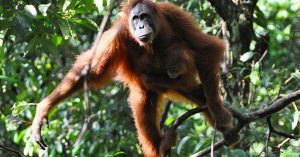
Orangutan
The Orangutan is a long-haired, orange/reddish primate, found only in Sumatra and Borneo. Orang-utans have an enormous arm span. A male is able to stretch his arms about 7 feet from fingertip to fingertip—a reach considerably longer than his standing height of about 5 feet. When they are standing upright, their hands nearly touch the floor. With four toes and an opposable big toe, orang-utans can grab things with their feet as well as their hands. They are also extremely strong – about eight times stronger than the average human. Orang-utans are more solitary than other apes and the males are loners. When they move through the forest they make heaps of rumbling and howling calls to guarantee that they stay out of each other’s way. The “long call” can be heard 1.2 miles away. They are the largest tree living animal and they are astonishingly relaxed and sensitive creatures.
Mothers give birth approximately every eight years. They have to be taught how to climb and training can last three to four years. Due to the strong bond between a mother and her young, the child stays with the mother for six or seven years until they develop the skills to live independently. Asia’s rainforests are being chopped down at an increasing rate, and because of the pet trade, the Orangutan’s existence is extremely threatened.
Sepilok Orang Utan Sanctuary
The Sepilok Orang Utan Rehabilitation Centre is located about 25 kilometers west of Sandakan in the state of Sabah, East Malaysia. It was founded in 1964 to rehabilitate orphan orangutans. The orphaned orangutans are trained to survive again in the wild and are released as soon as they are ready. The site is 43 sq km of protected land at the edge of Kabili Sepilok Forest Reserve. Today around 60 to 80 orangutans are living free in the reserve.
Bukit Lawang
Bukit Lawang is a small tourist village at the bank of Bahorok River in North Sumatra province of Indonesia and is known for the largest animal sanctuary of orangutans, called the Bohorok Centre for ex-captive Sumatran orangutans. This centre was established in 1973 by two Swiss zoologists, Regina Frey and Monica Boerner. Funding for this organisation was through the Frankfurt Zoological Society and the World Wildlife Fund. However, in 1980, it was taken over by the Indonesian government and hasn’t received any outside funding since. More than 200 orangutans were released into the Gunung Leuser National Park. The centre has been closed to admitting more orangutans since 1996, as it no longer met modern standards of species re-introduction.
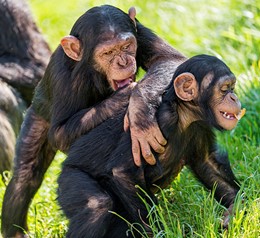
Chimpanzees
Chimpanzees are the closest living relative to humans and according to research by Mary-Claire King in 1973, she found 99% identical DNA between humans and chimpanzees, however, since that time, the percentage is perceived at 94% after newer studies were completed. Chimps are known to live in Tanzania and Zambia. They live in social communities of several dozen animals, and can adjust themselves to African rain forests, woodlands, and grasslands. They walk on all fours, which is called, knuckle-walking, where they clench their fists and support themselves on their knuckles. Chimpanzee feet are better suited for walking than are those of the orangutan because the chimp has broader soles and shorter toes.
A chimpanzee is recognized by his dark coat, hairless face, fingers, palms of the hands, and soles of the feet and the chimp is tailless. The exposed skin of the face, hands and feet varies from pink to very dark in both the common chimp and the bonobo, but is generally lighter in younger individuals and darkens as they mature.
One notable skill of chimpanzees is their ability to utilize tools for survival. They are only one of a few species that are capable of doing this. Chimpanzees shape and use sticks to retrieve insects from their nests or dig food out of logs. They also use stones to smash open delicious nuts and use leaves as sponges to soak up drinking water. Chimpanzees can even be taught to use some basic human sign language.
Chimpanzees live in large multi-male and multi-female social groups, which are called communities. Within a community, the position of an individual and the influence the individual has on others dictates a definite social hierarchy. Chimpanzees live in a leaner hierarchy wherein more than one individual may be dominant enough to dominate other members of lower rank. Typically, a dominant male is referred to as the alpha male. The alpha male is the highest-ranking male that controls the group and maintains order during disputes. Female chimpanzees also have a hierarchy, which is influenced by the position of a female individual within a group. In some chimpanzee communities, the young females may inherit high status from a high-ranking mother. Dominant females will also ally to dominate lower-ranking females: whereas males mainly seek dominant status for its associated mating privileges and sometimes violent domination of subordinates, females seek dominant status to acquire such resources as food.
Gombe Stream National Park
Gombe Stream National Park was established in 1968 and is located in western Kigoma Region, Tanzania. It is the smallest of Tanzania’s national parks, only accessible by boat and is home to a fragile strip of chimpanzee habitat. The chimpanzees here were made famous by the work of Jane Goodall, who traveled here in 1960 to study more about chimpanzee behavior and community structure. Goodall’s research eventually proved that chimpanzees have intellectual and emotional sophistication. With enormous support of renowned anthropologist Louis Leakey, Goodall set up a small research station in Gombe Stream in hopes of learning more about the behavior of our closest relatives.
The biodiversity of Gombe Stream National Park is primarily threatened by human intrusion. Although 25% of Tanzania is set aside in parks and reserves, wildlife populations are still diminishing. This is mainly due to the lack of collaboration between park management, government sectors, and rural communities. Village lands often lie between parks and become obstacles for animals traveling between protected areas. Without motivation to protect the animals, rural communities will hunt them for food or kill them for safety reasons. Poverty also increases the demand for bushmeat and forces farmers to clear increasingly large sections of forest for productive soils.
Chimfunshi Wildlife Organization
Chimfunshi Wildlife Orphanage is an orphanage and sanctuary for chimpanzees, located in Zambia’s Copperbelt Province. This sanctuary began when Sheila Siddle received a chimpanzee in 1983 that had been seized from Zairean poachers. Although the chimp wasn’t expected to live, Siddle nursed the animal back to health. Due to Siddle’s generous act of kindness, this pivotal moment turned Chimfunshi into an internationally recognized sanctuary and rehabilitation center. In fact, it is the only successful center of its kind in the world; surviving on the persistence and resourcefulness of David and Sheila as well the financial support of well wishers. Chimfunshi is home to over fifty chimpanzees housed in two enclosures – one walled and the other solar power electric fencing – with cages for the new introductions. With these new introductions, Chimfunshi is outgrowing itself and expanding to save and rehabilitate more animals.
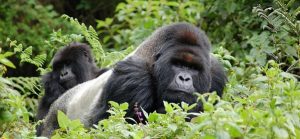
Mountain Gorilla
There are approximately 700 mountain gorillas left roaming Earth. Nearly half live in the forests of the Virunga Mountains in central Africa. These gorillas live on the green, volcanic slopes of Rwanda, Uganda, and the Democratic Republic of Congo and continue to face major threats from habitat loss and poaching. Physically, mountain gorillas have longer hair and shorter arms than their lowland cousins and are a tad larger than other gorillas. Although gorillas can climb trees, they are typically found on the ground in communities reaching up to 30 individuals.
It’s common that the older male gorilla, who leads the pack, is known as a silverback because of the strip of silver hair that decorates his otherwise dark fur. The leader organizes the gorillas’ basic activities of the day: eating, nesting and moving about in their home, which is commonly 0.75-to-16-square-mile. Gorillas have great strength and power but are generally calm and nonaggressive unless they are bothered. Furthermore, their eating habits are vegetarian, consisting of several foods, including: roots, shoots, fruit, wild celery, tree bark and pulp.
The only known enemies to the gorilla are leopards and humans. In western Africa, gorillas are commonly hunted for meat or in retaliation for crop raiding, but in eastern Africa they have been the victims of snares and traps set for antelope and other animals. Poachers have also destroyed entire family groups in their attempts to capture infant gorillas for zoos, while others are killed to sell their heads and hands as trophies.
Bwindi Impenetrable National Park
Bwindi National Park is located in south-western Uganda in East Africa. It encompasses approximately 128 square miles of jungle forests. The Bwindi Impenetrable National Park is a UNESCO designated World Heritage Site. The forest is one of the richest ecosystems in Africa, and the diversity of species is a feature of the park. The park provides habitat for some 120 species of mammals, 348 species of birds, 220 species of butterflies, 27 species of frogs, chameleons, geckos and many endangered species. The park is a sanctuary for colobus monkeys, chimpanzees and many birds. However, it is most notable for the 340 Bwindi gorillas, half the world’s population of the significantly endangered mountain gorillas.
Prior to Bwindi’s gazetting as a national park in 1991, the park was designated as a forest reserve and regulations about the right to access the forest were more liberal and not often enforced. Local people hunted, mined, logged, pit sawed, and kept bees in the park. It was announced as a national park in 1991 because of its rich biodiversity and threats to the integrity of the forest. Its designation as a national park gave the park higher protection status and state agencies increased protection and control of the park. Due to the fact that many mountain gorillas have been habituated to humans, they can get very close to the gorillas. Tourism is encouraged because this helps and protects the gorillas from bushmeat hunters. Gorilla tracking is the park’s main tourist attraction. Tourists wishing to track gorillas must first obtain a permit to do so. Selected gorillas families have been habituated to human presence and the number of visitors is tightly controlled to prevent degradation of the habitat and risks to the gorillas. Gorilla tracking yields much revenue for Uganda Wildlife Authority and the gorillas seldom react to tourists.
Western Lowland Gorilla
The western lowland gorilla is quite similar to its relative, the mountain gorilla; however, even though they are endangered, they are more common than their relatives. Western lowland gorillas tend to be a bit smaller than their mountain cousins. They also have shorter hair and longer arms with a brown-grey coat and auburn chest. Additionally, they have wider skulls and more pronounced brow ridges and smaller ears. The western lowland gorilla is the most numerous and widespread of all gorilla subspecies. Populations can be found in Cameroon, the Central African Republic, the Democratic Republic of Congo and Equatorial Guinea as well as in large areas in Gabon and the Republic of Congo.
With wildlife refuges protecting the various primate families, there is hope for the continuation of all of these endangered species. From monkeys, apes, baboons, chimpanzees to gorillas and more, these creatures are important to our environment and must be viewed as a part of our world, not as simply food, attractions or prized possessions.
More Information
Safari Bookings
The largest online marketplace for African safari holidays

